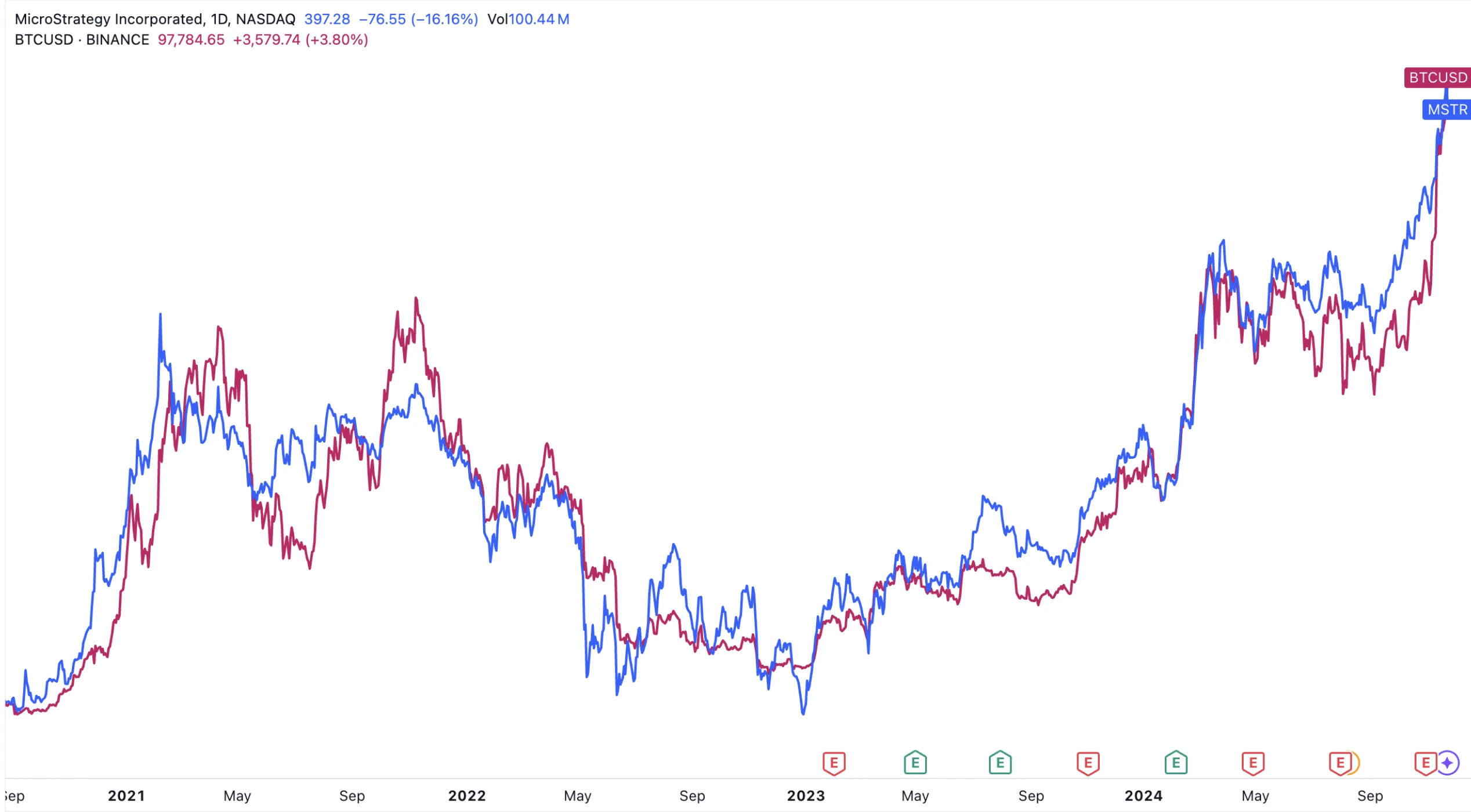
- MicroStrategy’s Bitcoin Strategy: MicroStrategy became the largest Bitcoin holder, using debt to fund purchases, resulting in substantial profits as Bitcoin’s price rose.
- In 2020, MicroStrategy shifted from software to Bitcoin, using it as a hedge against inflation and to counter stagnation in its business.
- Despite controversy, the Bitcoin investment boosted MicroStrategy’s stock by 2500% from 2020 to 2024, proving the value of bold strategy.
TABLE OF CONTENTS

As Bitcoin’s price reaches a new all-time high, MicroStrategy’s stock price has also surged, with its growth matching that of Bitcoin.
MICROSTRATEGY’S BITCOIN HOLDINGS AND FINANCIAL STRATEGY
Under the leadership of Chairman Michael Saylor, MicroStrategy has almost become synonymous with Bitcoin. As of now, MicroStrategy and its subsidiaries hold approximately 331,200 Bitcoins, with a total investment of $16.5 billion, at an average purchase price of $49,874. At the current Bitcoin price of $98,842, MicroStrategy’s Bitcoin holdings have a paper profit of $16.218 billion.

According to Bitcoin Treasuries, MicroStrategy is the largest publicly traded company holding Bitcoin, surpassing Bitcoin mining firms like Marathon, Riot, and major crypto exchanges such as Coinbase. Notably, MicroStrategy has also raised funds by issuing debt to buy more Bitcoin. Analysts expect that MicroStrategy still has around $15.3 billion in funds and may continue its aggressive buying strategy, which is likely to last until the end of the year.
Founded in 1989 and headquartered in Virginia, MicroStrategy initially focused on Business Intelligence (BI) and data analytics, offering various software products to help businesses collect, process, and analyze data, thus improving operational efficiency and decision-making quality. However, in 2020, MicroStrategy made an unexpected decision—shifting its cash reserves into Bitcoin. This decision was led by the company’s co-founder and chairman, Michael Saylor.
Saylor identified three key reasons for this move:
1. Hedge Against Inflation: In 2020, the global economy faced a severe downturn due to the pandemic, with central banks worldwide implementing large-scale monetary easing policies, which increased the risk of currency devaluation. Saylor believed Bitcoin’s scarcity and decentralized nature made it a better tool for hedging against inflation than traditional cash or securities.
2. Stagnant Revenue Growth: MicroStrategy’s traditional software business was facing stagnating revenue growth. Although it remained a key player in the business intelligence market, the company faced increasing competition. MicroStrategy needed to find new avenues to improve its financial performance.
3. The Potential of Bitcoin: Saylor saw the enormous potential Bitcoin had in the capital markets. Since 2010, Bitcoin had experienced strong value growth, attracting more and more investors. Saylor viewed Bitcoin not just as a cryptocurrency, but as “digital gold,” offering similar hedge functions as gold, while also having high liquidity and global recognition, making it an important asset for portfolio diversification.
MICHAEL SAYLOR’S STRATEGIC DECISION AND MARKET RESPONSE
Against this backdrop, MicroStrategy began allocating large amounts of capital into Bitcoin and rapidly accumulated significant Bitcoin reserves. Saylor’s investment logic was clear:
• Bitcoin as a Reserve Asset: MicroStrategy regarded Bitcoin as a core reserve asset on its balance sheet, believing that the price of Bitcoin would continue to rise in the long term, making it a strategic tool for hedging against inflation and increasing the company’s value.
• Capital Structure Innovation: To further increase its Bitcoin holdings, MicroStrategy started raising funds through stock issuance and convertible bonds. This innovative capital structure allowed the company to continue accumulating Bitcoin without negatively impacting the development of its traditional business.
MicroStrategy’s transformation strategy sparked widespread discussion and controversy. Some analysts believed that this approach was too risky due to Bitcoin’s high volatility, which could lead to instability in the company’s financial situation. However, as Bitcoin prices surged, MicroStrategy’s stock price also experienced significant growth, quickly becoming the largest publicly traded holder of Bitcoin, with its stock performance even surpassing both traditional equities and Bitcoin itself.
In hindsight, this decision by MicroStrategy was undoubtedly very wise. From mid-2020 to 2024, Bitcoin’s price increased by 700%, while MicroStrategy’s stock price surged by around 2500%, making it one of the best-performing companies in the U.S. stock market. Even though the company’s traditional business revenues declined, its investment in Bitcoin generated massive capital appreciation, providing substantial returns for shareholders.
By making Bitcoin the core part of its balance sheet, MicroStrategy demonstrated bold strategic thinking. At a time when many traditional companies were skeptical about cryptocurrencies, MicroStrategy’s founder, Michael Saylor, recognized Bitcoin’s potential as “digital gold” and used it as a tool for hedging against inflation. While this decision may have seemed risky at the time, it ultimately proved the value of strategic insight and innovative thinking. Such strategic decisions require keen market awareness and the ability to anticipate future trends.
In conclusion, MicroStrategy’s Bitcoin investment not only brought substantial returns to the company but also provided valuable lessons on how to formulate long-term strategies and flexibly manage capital in a rapidly changing market.
▶ Buy Crypto at Bitget
CoinRank x Bitget – Sign up & Trade to get $20!




















